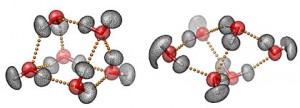Glass isn’t transparent (at the molecular scale) as it’s cooling and scientists have been curious about this transition from liquid to glass state. According to an Oct. 15, 2012 posting by Carol Clark for Emory University’s eScienceCommons, a team from Emory University (and New York University) has cracked this mystery. First, here’s more about the mystery (from Clark’s article)
Scientists fully understand the process of water turning to ice. As the temperature cools, the movement of the water molecules slows. At 32 F, the molecules lock into crystal lattices, solidifying into ice. In contrast, the molecules of glasses do not crystallize.The movement of the glass molecules slows as the temperature cools, but they never lock into crystal patterns. Instead, they jumble up and gradually become glassier, or more viscous. No one understands exactly why.
The phenomenon leaves physicists to ponder the molecular question of whether glass is a solid, or merely an extremely slow-moving liquid.
This purely technical physics question has stoked a popular misconception: That the glass in the windowpanes of some centuries-old buildings is thicker at the bottom because the glass flowed downward over time.
“The real reason the bottom is thicker is because they hadn’t yet learned how to make perfectly flat panes of glass,” Weeks says [Emory physicist Eric Weeks]. “For practical purposes, glass is a solid and it will not flow, even over centuries. But there is a kernel of truth in this urban legend: Glasses are different than other solid materials.”
Speaking more technically about the transition,
“Cooling a glass from a liquid into a highly viscous state fundamentally changes the nature of particle diffusion,” says Emory physicist Eric Weeks, whose lab conducted the research. “We have provided the first direct observation of how the particles move and tumble through space during this transition, a key piece to a major puzzle in condensed matter physics.”
Weeks specializes in “soft condensed materials,” substances that cannot be pinned down on the molecular level as a solid or liquid, including everyday substances such as toothpaste, peanut butter, shaving cream, plastic and glass.
The scientists have prepared a video animation of what they believing is occurring as glass cools (no sound),
Here’s what the movie depicts (from the Clark article),
The movie and data from the experiment provide the first clear picture of the particle dynamics for glass formation. As the liquid grows slightly more viscous, both rotational and directional particle motion slows. The amount of rotation and the directional movements of the particles remain correlated.
“Normally, these two types of motion are highly coupled,” Weeks says. “This remains true until the system reaches a viscosity on the verge of being glass. Then the rotation and directional movements become decoupled: The rotation starts slowing down more.”
He uses a gridlocked parking lot as an analogy for how the particles are behaving. “You can’t turn your car around, because it’s not a sphere shape and you would bump into your neighbors. You have to wait until a car in front of you moves, and then you can drive a bit in that direction. This is directional movement, and if you can make a bunch of these, you may eventually be able to turn your car. But turning in a crowded parking lot is still much harder than moving in a straight line.”
There’s more about the work and team in Clark’s article. H/T to the Oct. 16, 2012 news item on Nanowerk for alerting me to this work. You can find the article the researchers have written at the Proceedings of the National Academy of Sciences (PNAS),
Decoupling of rotational and translational diffusion in supercooled colloidal fluids by Kazem V. Edmond, Mark T. Elsesser, Gary L. Hunter, David J. Pine, and Eric R. Weeks. Published online before print October 15, 2012, doi: 10.1073/pnas.1203328109 PNAS October 15, 2012
The article is behind a paywall.
